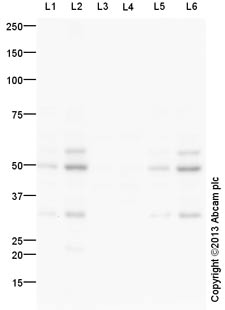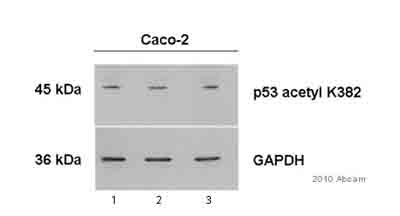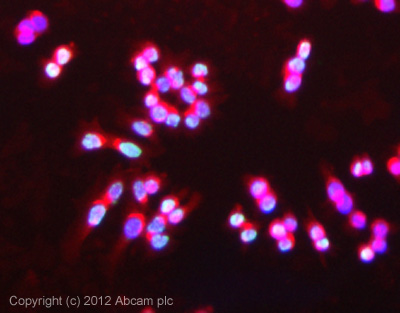Anti-p53 (acetyl K382) antibody
| Name | Anti-p53 (acetyl K382) antibody |
|---|---|
| Supplier | Abcam |
| Catalog | ab37318 |
| Prices | $398.00 |
| Sizes | 100 µg |
| Host | Rabbit |
| Clonality | Polyclonal |
| Isotype | IgG |
| Applications | IHC-P WB ICC/IF ICC/IF |
| Species Reactivities | Human |
| Antigen | Synthetic peptide conjugated to KLH derived from within residues 350 to the C-terminus of Human p53 |
| Blocking Peptide | Human p53 (acetyl K382) peptide |
| Description | Rabbit Polyclonal |
| Gene | TP53 |
| Conjugate | Unconjugated |
| Supplier Page | Shop |
Product images
Product References
Binding of the histone chaperone ASF1 to the CBP bromodomain promotes histone - Binding of the histone chaperone ASF1 to the CBP bromodomain promotes histone
Das C, Roy S, Namjoshi S, Malarkey CS, Jones DN, Kutateladze TG, Churchill ME, Tyler JK. Proc Natl Acad Sci U S A. 2014 Mar 25;111(12):E1072-81. doi:
Basal dynamics of p53 reveal transcriptionally attenuated pulses in cycling - Basal dynamics of p53 reveal transcriptionally attenuated pulses in cycling
Loewer A, Batchelor E, Gaglia G, Lahav G. Cell. 2010 Jul 9;142(1):89-100.
Direct association of Sprouty-related protein with an EVH1 domain (SPRED) 1 or - Direct association of Sprouty-related protein with an EVH1 domain (SPRED) 1 or
Li D, Jackson RA, Yusoff P, Guy GR. J Biol Chem. 2010 Nov 12;285(46):35374-85.
Acquired vorinostat resistance shows partial cross-resistance to - Acquired vorinostat resistance shows partial cross-resistance to
Dedes KJ, Dedes I, Imesch P, von Bueren AO, Fink D, Fedier A. Anticancer Drugs. 2009 Jun;20(5):321-33.


